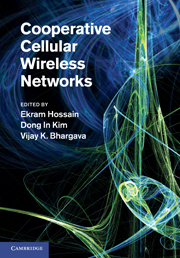Book contents
- Frontmatter
- Contents
- List of contributors
- Preface
- Part I Introduction
- Part II Cooperative base station techniques
- Part III Relay-based cooperative cellular wireless networks
- 6 Distributed space-time block codes
- 7 Collaborative relaying in downlink cellular systems
- 8 Radio resource optimization in cooperative cellular wireless networks
- 9 Adaptive resource allocation in cooperative cellular networks
- 10 Cross-layer scheduling design for cooperative wireless two-way relay networks
- 11 Green communications in cellular networks with fixed relay nodes
- 12 Network coding in relay-based networks
- Part IV Game theoretic models for cooperative cellular wireless networks
- Part V Standardization activities
- Index
9 - Adaptive resource allocation in cooperative cellular networks
from Part III - Relay-based cooperative cellular wireless networks
Published online by Cambridge University Press: 03 May 2011
- Frontmatter
- Contents
- List of contributors
- Preface
- Part I Introduction
- Part II Cooperative base station techniques
- Part III Relay-based cooperative cellular wireless networks
- 6 Distributed space-time block codes
- 7 Collaborative relaying in downlink cellular systems
- 8 Radio resource optimization in cooperative cellular wireless networks
- 9 Adaptive resource allocation in cooperative cellular networks
- 10 Cross-layer scheduling design for cooperative wireless two-way relay networks
- 11 Green communications in cellular networks with fixed relay nodes
- 12 Network coding in relay-based networks
- Part IV Game theoretic models for cooperative cellular wireless networks
- Part V Standardization activities
- Index
Summary
Introduction
The cellular structure is a central concept in wireless network deployment. A wireless cellular network comprises base stations geographically located at the centre of each cell serving users within the cell boundary. The assignment of the users to the base stations depends on the relative channel propagation characteristics. As a mobile device can usually receive signals from multiple base stations, the mobile is typically assigned to the base station with the strongest channel gain. Signals from all other base stations are regarded as intercell interference. However, at the cell edge, it is often the case that the propagation path-losses from two or more base stations are similar. In this case, the signal-to-noise-and-interference ratio (SINR) could be close to 0 dB, even if the mobile is assigned to the strongest base station. To avoid excessive intercell interference in these cases, traditional cellular networks employ a fixed frequency reuse pattern so that neighboring base stations do not share the same frequency. In this manner, neighboring cells are separated in frequency so that cell-edge users do not interfere with each other.
The traditional fixed frequency reuse schemes are effective in minimizing intercell interference, but are also resource intensive in the sense that each cell requires a substantial amount of nonoverlapping bandwidth, so that only a fraction of the total bandwidth can be made available for each cell. Consequently, the standardization processes for future wireless systems have increasingly targeted maximal frequency reuse, where all cells use the same frequency everywhere.
- Type
- Chapter
- Information
- Cooperative Cellular Wireless Networks , pp. 233 - 258Publisher: Cambridge University PressPrint publication year: 2011
- 10
- Cited by



